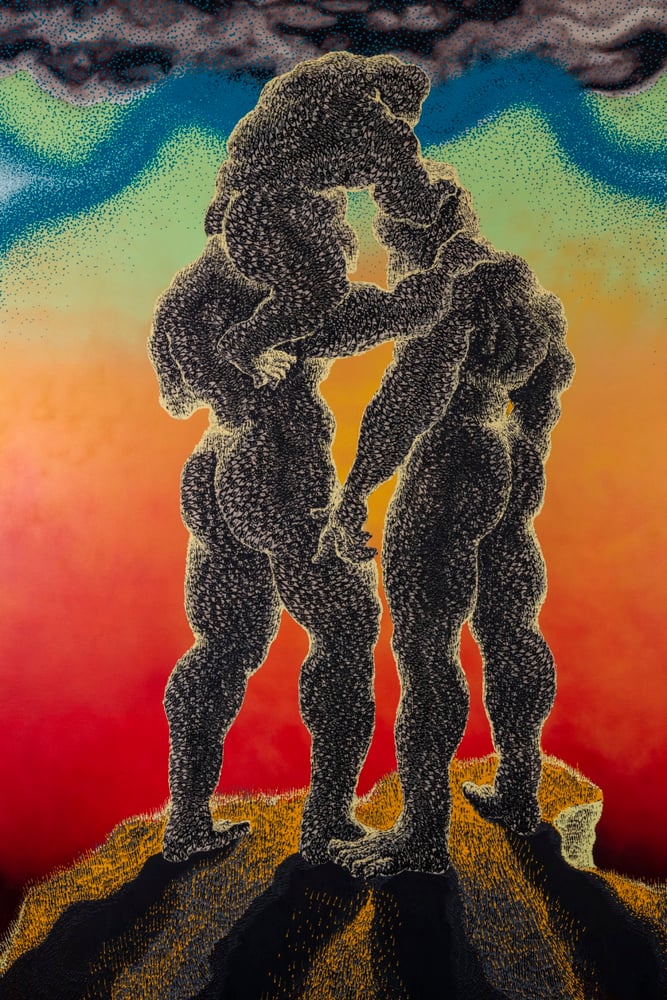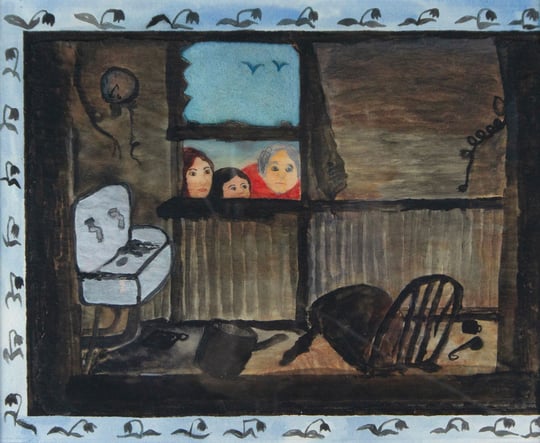
I sit outside of the Museum of Contemporary Art, North Miami (MOCA North Miami) pondering the art museum’s function as a home. Visitors walk inside the exhibition halls and witness an artist’s personal story on display, respecting that narrative enough not to poke or prod past distant observation. Curated by Adeze Wilford, the museum invites visitors to reflect on the power of the visual scenes on its walls and, from there, can choose to either accept what is being shown to them—finding clarity and a shared experience—or resist the premise justifying that particular showcase. Who are you in conversation with in this shared house?
Looking up at the braided and adorned black hair swinging from the tall trunks of the palm trees scattered throughout MOCA’s plaza, I learn more about the exhibitions on display and how the museum’s architectural design—perhaps unintentionally—weaves the shows into a narrative, situating the works and artists in conversation with one another. Greeting you upon arrival was the generational, labor-intensive process of Black women’s beauty through Miami-based artist Chire “VantaBlack” Regans’ public art installation titled To What Lengths, on view from October 14, 2022 to January 20, 2023. Each braid represented a woman in Chire’s family.
Past the entrance doors was the star of the current season: Didier William’s solo exhibition depicting the Haitian American artist’s upbringing and eventual departure out of Miami into his current Philadelphia home as curated by Dr. Erica Moiah James, Ph.D. To walk through Didier William: Nou Kite Tout Sa Dèyè was to discover what it is to live in North Miami—a neighborhood where Afro-Caribbeans find themselves rooted in the predominantly Haitian community now residing in the city’s radius.

The energy of being a local was very much felt when outside in the open air plaza and initially inside of MOCA North Miami. During the transitory rat race of the annual Miami Art Week, it felt more and more like those seven days were an excusatory plundering of the city’s resources in order to pander to those who have no stake or long-term commitment in the local, visual art scene. For MOCA North Miami, the duality of both artists and curators who are rooted to some degree to the city of Miami is a well-needed breath of fresh air and an ease on one’s shoulders—whose actions in actively exhibiting and commissioning Miami-based artists speak louder than superfluous words claiming to “support local.”
It’s worth recognizing when you are a guest in a home that does not belong to you.
Announced calls for public art transform into palpable outdoor displays where initial submissions now rest on view for anyone walking by to contemplate, while a museum that stands as one of the consistent pillars for the arts in the North Miami area welcomed back a Miami-grown painter with open arms. I chose this backyard-style opening reception with familiar faces I’ve grown to know and cherish throughout my young stint in arts administration and was warmed by the necessity of community in showing up for one another despite the distraction of such an event-packed party week.
It’s refreshing to witness an institution uplifting and displaying the stories of those who live in the area surrounding its closed-off walls. This is my sentiment until I spied a small alcove of an entrance leading into Leah Gordon: Kanaval. The exhibition depicted over twenty years of Carnival in Haiti through the medium format lens of a British-born Leah Gordon, and I began to wonder why this photography series was placed next to Didier’s work. Is it because it depicted Haiti out of the island itself as opposed to the offshore immigrant experience of being Haitian and raised in Miami? Why was Kanaval necessary at the same time as Didier William: Nou Kite Tout Sa Dèyè, even serving as the final concluding interior vista for a visitor to MOCA North Miami? As the end of the three concurrent exhibitions on view, it’s as if Leah Gordon’s focus exhibition became the concluding tone for viewers who have traveled from start to finish at the museum, shaping their last thoughts before exiting the space. Why were these exhibitions all happening and opening at once—and why was Leah Gordon the last one you see of the three?
I think about the testy lens through which a white British photographer is portraying Haitian culture and individuals to a predominantly Caribbean community, especially coming into those opportunities to photograph as a result of marrying a Haitian partner. I felt uncomfortable while seeing a white lens on Haitian identity on view and juxtaposed against a Black artist of direct Haitian descent. While the work is technically masterful in its execution, I considered who steers its depiction and why the works must be in conversation in the first place.
When I asked Adeze Wilford, Curator at MOCA North Miami, about these concerns, she responded with the following:
“The museum has had a long history of collaborating with Leah through our critically acclaimed presentation of PÒTOPRENS, which is when the institution learned about her personal photography practice. Leah has been working with the Jacmel community photographing and recording oral histories with the members of these troupes for several decades. She’s built long-standing relationships with each person represented in the show and her photographs and film chronicle a community over many years. Both Leah and I were intentional about centering the voices of the subjects in her photos in the gallery because that aspect of the work is crucial to her practice. These shows are highlighting perspectives of Haitian culture and history through personal storytelling.”
The personal is political. I suppose you can argue who better to tell the stories of those who live in one of the most financially and environmentally vulnerable geographies in the world than an internationally recognized artist so intertwined in Haiti’s culture by pure fascination. Care as a holder of perception and representation is possible, but the possibility is predicated by privilege. I find it disconcerting to think of the innate privileges afforded to a white woman entering this island and the access she has to platforms outside of it that allow her gaze to reach prominence. To come and go as she pleases, and especially the opportunities afforded to her as an outsider of the culture, only magnifies the inevitable exoticization of Haiti. Cited in critic and curator Veerle Poupeye’s Caribbean Art (World of Art) is the following commentary:
“The role of Leah Gordon […] and international organizations in the international exposure of the [Ghetto Biennale] collective, however, illustrates that it is difficult to step away from externally mediated representation in a global art world which still maintains many of its old hierarchies.”
A white European woman herself, Poupeye spotlights the controversial reality of who is really pulling the strings behind the curtain. If Leah Gordon: Kanaval served a contextual purpose, it was to heighten how much more authentic the Haitian immigrant experience was in Didier William: Nou Kite Tout Sa Dèyè and the curatorial sensitivity of Dr. James, Ph.D. The reality of a watchful gaze does not escape those taking in the painted wood panels brimming with carved eyes. William purposely cloaks his amorphous subjects in this repeated pattern as a resistance to the Black body as systemically surveilled upon. There is a delicate elegance to ensuring each eye is etched into the surface of the bodies floating throughout the twenty-five paintings that were on view, and extending into a subtle dark wallpaper that encased the first room on the right when you entered.

From the small and large wood panels depicting everything from a held chancleta ready to strike at a cockroach to the bus ride to New World School of the Arts of a young arts student carrying the weight of being the English representative for his small family of four, water as a conductor of life and death played a significant role in the showcase. On the exhibition catalog’s cover is the small-format violence of Island (2022): a 31 x 22 inch acrylic and wood carving on panel work of a head seen trying to stay afloat above waves. The sea expels towards the heavens through the subject’s vacant eyes, which now serve as portals of pain in transmitting the treacherous duality of an ocean. A passageway that many have risked journeying along only to drown or be washed ashore and eventually sent back to their exiled homes, the sea and the exhibition’s title in original Haitian Kreyòl are continuous nods to those whose homelands are not so distant and yet decades away in memory.
Care as a holder of perception and representation is possible, but the possibility is predicated by privilege.
I can’t seem to shake the narrative found in the work titled 84 Corolla (2021). After learning more about the queer family William has built for himself through his husband and two children, the accompanying wall label revealed the coming-of-age innocence of this moment in time when William could only live in the presentness of his desire.

Finding safety in the wrecked structure of his brother’s car, William recalls the first time he explored being with a man in his youth, one who happened to be his next door neighbor. The scary proximity of committing such sexual exploration right next to the home his Caribbean-born parents were soundly sleeping in is an act of bravery that I’ve found myself in before—protesting the outspoken warnings of necessary caution that my immigrant Cuban parents tried to shelter me in while growing up in South Florida.

What resounds the most in 84 Corolla—aside from the sky blue and infrared reds and oranges radiating around the two bodies—is the open “cage” that encapsulates the subjects. There is a freeness in being able to move in and between the crushed metal bars of this vehicle, which will eventually affirm the artist in his ability to live openly as a queer immigrant figure in both his family and the roster of Haitian American artists that stand as his contemporaries.
Gifted this past February with a key to the City of North Miami, William’s return as an established artist to the landscape of a changed Miami from what he knew growing up gives back to those living within the city limits. Wilford explains in stating, “Didier has provided an incredible gift to North Miami through our print distribution project. We’ve been giving away 200 prints by him to residents of the city. The gratitude and response to having a work like this in our community has been phenomenal. It adds another layer to the story of his show which is so rooted in his lived experiences here.” It’s worth recognizing when you are a guest in a home that does not belong to you. For Didier William: Nou Kite Tout Sa Dèyè, those driving the storytelling are trusted inhabitants paying a nostalgic ode and homage to North Miami, as an exhibition that spoke about the community directly and within its vicinity.

This piece was published in partnership with Oolite Arts as part of a project to increase critical arts coverage in Miami-Dade County.





